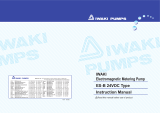
5
4. General information
4.1 Applications
The DMX 221 pump is suitable for liquid, non-abrasive and non-
inflammable media strictly in accordance with the instructions in
this manual.
The DMX 221 dosing pumps have not been approved according
to the EC directive 94/9/EC, the so-called ATEX directive. The
application of these pumps in potentially explosive environments
according to ATEX directive is therefore not permitted.
4.2 Warranty
Warranty in accordance with our general terms of sale and
delivery is only valid
• if the pump is used in accordance with the information within
this manual.
• if the pump is not dismantled or incorrectly handled.
• if repairs are carried out by authorised and qualified
personnel.
• if original spare parts are used for repairs.
5. Safety
This manual contains general instructions that must be observed
during installation, operation and maintenance of the pump. This
manual must therefore be read by the installation engineer and
the relevant qualified personnel/operators prior to installation and
start-up, and must be available at the installation location of the
pump at all times.
It is not only the general safety instructions given in this "Safety"
section that must be observed, but also all the specific safety
instructions given in other sections.
5.1 Identification of safety instructions in this manual
If the safety instructions or other advice in this manual are not
observed, it may result in personal injury or malfunction and
damage to the pump. The safety instructions and other advice are
identified by the following symbols:
Information provided directly on the pump, e.g. labelling of fluid
connections, must be observed and must be maintained in a
readable condition at all times.
5.2 Qualification and training of personnel
The personnel responsible for the operation, maintenance,
inspection and installation must be appropriately qualified for
these tasks. Areas of responsibility, levels of authority and the
supervision of the personnel must be precisely defined by the
operator.
If the personnel do not have the necessary knowledge, the
necessary training and instruction must be given. If necessary,
training can be performed by the manufacturer/supplier at the
request of the operator of the pump. It is the responsibility of the
operator to make sure that the contents of this manual are
understood by the personnel.
5.3 Risks when safety instructions are not observed
Non-observance of the safety instructions may have dangerous
consequences for the personnel, the environment and the pump.
If the safety instructions are not observed, all rights to claims for
damages may be lost.
Non-observance of the safety instructions may lead to the
following hazards:
• failure of important functions of the pump/system
• failure of specified methods for maintenance
• harm to humans from exposure to electrical, mechanical and
chemical influences
• damage to the environment from leakage of harmful
substances.
5.4 Safety-conscious working
The safety instructions in this manual, applicable national health
and safety regulations and any operator internal working,
operating and safety regulations must be observed.
5.5 Safety instructions for the operator/user
Hazardous hot or cold parts on the pump must be protected to
prevent accidental contact.
Leakages of dangerous substances (e.g. hot, toxic) must be
disposed of in a way that is not harmful to the personnel or the
environment. Legal regulations must be observed.
Damage caused by electrical energy must be prevented (for more
details, see for example the regulations of the VDE and the local
electricity supply company).
5.6 Safety instructions for maintenance, inspection
and installation work
The operator must ensure that all maintenance, inspection and
installation work is carried out by authorised and qualified
personnel, who have been adequately trained by reading this
manual.
All work on the pump should only be carried out when the pump is
stopped. The procedure described in this manual for stopping the
pump must be observed.
Pumps or pump units which are used for media that are harmful
to health must be decontaminated.
All safety and protective equipment must be immediately
restarted or put into operation once work is complete.
Observe the points described in the initial start-up section prior to
subsequent start-up.
5.7 Unauthorised modification and manufacture of
spare parts
Modification or changes to the pump are only permitted following
agreement with the manufacturer. Original spare parts and
accessories authorised by the manufacturer are safe to use.
Using other parts can result in liability for any resulting
consequences.
Warning
Other applications or the operation of pumps in
ambient and operating conditions, which are not
approved, are considered improper and are not
permitted. Grundfos Alldos accepts no liability
for any damage resulting from incorrect use.
Warning
If these safety instructions are not observed,
it may result in personal injury!
Caution
If these safety instructions are not observed,
it may result in malfunction or damage to the
equipment!
Note
Notes or instructions that make the job easier
and ensure safe operation.
Warning
Electrical connections must only be carried out
by qualified personnel!
The pump housing must only be opened by
personnel authorised by Grundfos Alldos!





















